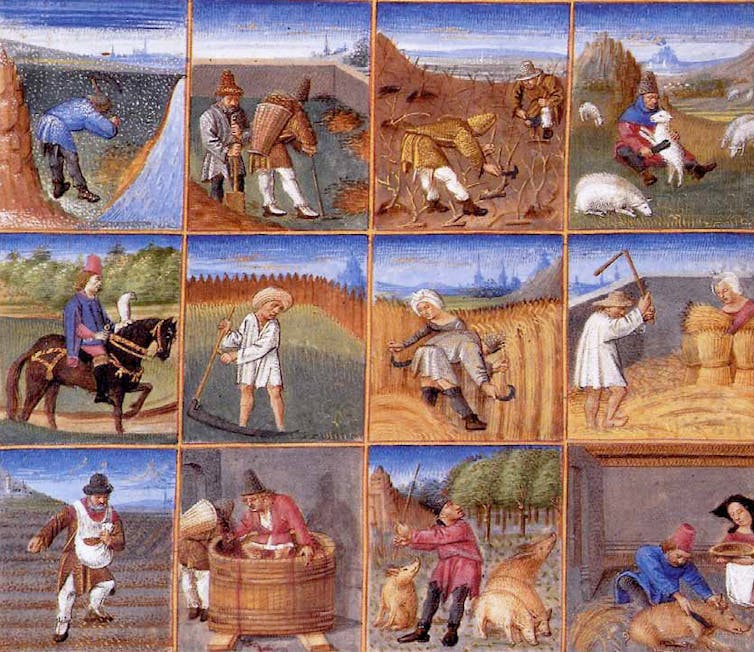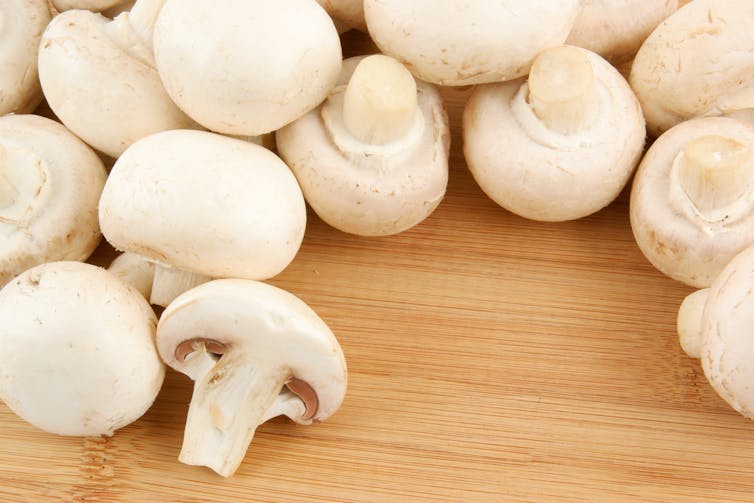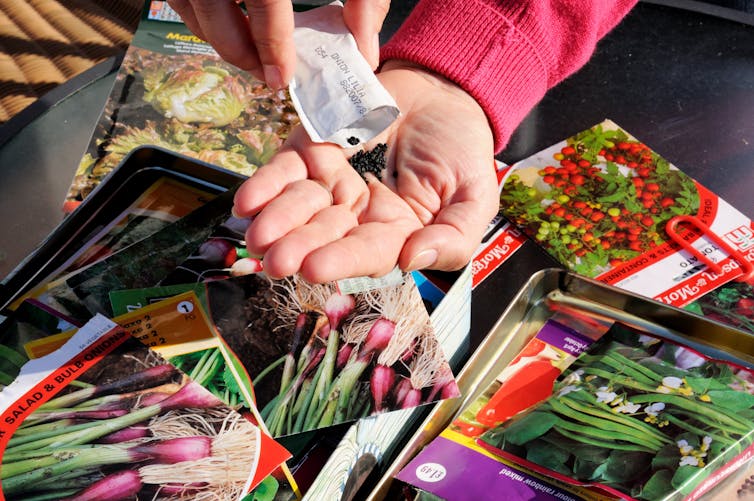Michael Wick/Shutterstock.com
Nicola Patron: Oil from soybeans gene-edited to produce a “high oleic” oil with no trans fats and less saturated fat is already on sale in the United States. Other products including low-acrylamide potatoes and non-browning mushrooms are expected to be launched in the near future.
The work I do might lead to similar products. I’m a molecular and synthetic plant biologist at the Earlham Institute. My lab works to understand how plants control when and why genes are expressed as well as how they make certain chemicals. We aim to identify variants of genes that help plants to grow and to find and produce natural products like pheromones that are useful in agriculture or anti-cancer compounds used in chemotherapies. We also work to improve plant biotechnologies and have contributed to proof-of-concept studies demonstrating that genome editing can be used to develop useful traits in barley, brassica and potatoes by deleting just a few letters of DNA.
Catherine Price: It’s great to be able to talk to a scientist working in this field, because GM crops have long been a very contentious issue, and for good reason. My work focuses on the social science aspects of the GM debate. I’m a sociologist based at a research group at the University of Reading looking at the future of agriculture. In previous work I’ve examined how GM food is discussed by the media, so I have a good sense of how the state, NGOs, farmers, and citizens all view the science of GM foods – and it varies quite a bit.
So what exactly is the difference between GM and gene editing? I’ve come across many definitions in my time working on this topic.
NP: I’m not surprised! There isn’t really an accepted definition of what genetic modification is, and that has certainly caused some problems. One could argue that the genetics of anything that’s been manipulated by humans has been modified in some way. We’ve been changing plant genomes for thousands of years. The process of domesticating and breeding crops made substantial changes to the sequences and structures of their genomes.

Condé Museum
Since the 1980s, we’ve had the ability to use recombinant DNA technologies to insert DNA sequences into plant genomes in order to confer useful traits, such as resistance to insect pests. This could be a DNA sequence from a different individual of the same species, from a closely related species, or from a more distantly related species. Such crops became known as genetically modified organisms (GMOs). They first came on to the markets in the 1990s and are now widely grown on about 10% of agricultural land worldwide in 29 countries.
The outcomes of gene editing are quite different to those of GM. What genome editing technologies allow you to do is to make really precise changes to the DNA that already exists in an organism. You can delete something, even changing or deleting just one specific letter of the DNA code, or you can recode a longer section of a sequence. You can also use these technologies to insert DNA, but instead of inserting the new DNA randomly as happens with older GM technologies, you can insert it into a specific location in the genome.

This is a Head to Head story
The Conversation’s Head to Head articles feature academics from different disciplines chewing over current debates. If there’s a specific topic or question you’d like experts from different disciplines to discuss, please email us your question.
Broadly, genetic modification has come to mean that one or more genes have been inserted whereas genome editing has come to mean small and specific changes to existing DNA.
‘Frankenfood’
CP: You’ve just explained the science really clearly. And I think that might be what we’re missing in terms of the public debate – where often the loudest sentiment is that these technologies are unnatural or dangerous.
In previous work I’ve analysed how journalists frame genetics news. Journalists often liken the rearrangement and changes to genes to Frankenstein and the idea of runaway science. This is turn can invoke the idea that scientific progress interferes with nature, producing results which are unpredictable and ethically wrong.

Valerii Evlakhov/Shutterstock
In 2015, for example, these Frankenfood headlines dominated. There were a lot of people who were for it too, but I got the overall sense that it was deemed a risk and that part of the problem was that scientists didn’t try hard enough to explain the technical stuff and the risks, and that the public’s concerns weren’t being listened to. I think sometimes we treat the public as being stupid. If the science isn’t explained and the public aren’t consulted, what are they supposed to think?
In the UK, the gene-editing debate has sparked again. When Boris Johnson came into power, he stood on the steps of Downing Street and said he wanted to enable gene edited and genetically modified crops. This led to a government consultation on the matter. The proposed changes – yet to be announced formally – define gene-edited organisms as those “possessing genetic changes which could have been introduced by traditional breeding”.
But has the dominant view changed since 2015? It’s not clear. There are also concerns that weakened regulations will lock the UK into industrialised farming methods. And there’s no real sense of how gene edited or GM crops fit into the broader food system. Agriculture does not operate and exist in isolation.
NP: I totally agree that there was insufficient communication in the past. People do understand the science if it is explained in a considered way. One thing I have found is that it’s important for people to understand that all crop breeding techniques involve rearrangements and changes to genes. The risks of using these new breeding technologies are no greater than for older breeding technologies, the products of which are subject to far fewer checks. For the most part, what domestication and plant breeding has achieved is to remove toxins and to make them more nutritious and more high yielding.
In the summer of 2018, the European court of justice ruled that genome edited plants would also be classified as being genetically modified. But, if a plant was mutated using radiation or mutagenic chemicals, even if the results were exactly the same (or had even more changes), the plant would not be GM. To many, this doesn’t make much sense. When there are no new genes inserted, I struggle to understand how and why plants mutated with these technologies should be regulated in a different way. That’s why European law in this area is controversial.
Now with the UK being able to divert from European law post-Brexit, there is a discussion of whether that’s something that the country wants to keep. This is particularly relevant if the UK wants its agricultural products to be competitive on the wider global market with products from the United States and Canada and Brazil and Australia, who have decided not to regulate genome edited products in the same way that they do genetically modified products.
CP: It’s the rearrangements and changes to genes which the media often pick up on. And this is where the idea of Frankenstein food gets brought into debates about GM foods. I think this illustrates why scientists need to communicate the risks rather than leaving it to journalists. The public are likely to have a better understanding then.
The case for editing
NP: Genetic rearrangements and changes to the sequences of genes occur naturally all the time. They also occur with older and established breeding technologies. Applying genetic technologies to crop breeding makes the process of bringing combinations of beneficial sequences and genes together into the same plant easier. Because scientists know what changes are being made, the consequences of these changes are closely observed and extensively analysed even before the plants enter large-scale breeding programmes. The outcomes of gene editing are therefore more likely to be predictable.
I think what is critically important is for scientists to explain what we’re trying to achieve and the type of products we’re able to make – why they will be beneficial, both to health and the environment.
We’re using an incredible amount of land and water for agriculture. And that often means that we are destroying pristine biodiverse environments, such as the Amazon rainforest, grasslands, wetlands and marshlands to grow more crops. Increasing yield on productive land and decreasing the amount of land used for agriculture is possibly the greatest impact that we will have on preserving biodiversity. Improving crop genetics can also reduce the amount of fertilisers and pesticides that we need to use, and we can make crops healthier, and increase their nutritional content.
A single change to one letter of DNA sequence can turn off a gene and have a substantial effect. For example, making a single mutation to inactivate two genes involved in fatty acid biosynthesis can lead to a different oil profile in oil seed crops making them healthier to consume. Plants also have genes that make them resistant or susceptible to specific diseases – a mutation in the coding sequence or in the regulatory sequences of these genes can mean that those pathogens can no longer infect them, which can reduce the need for fungicides and other chemicals.
Scientific analyses that have been done on the impacts of many biotech crops have identified many benefits, including reducing the use of pesticides and improving the welfare and health of subsistence farmers.
I think it’s really important that people understand that even when the goal is to increase yields, crop improvement is not only about profit.
Power in the seed system
CP: I’d certainly agree with you that these are very pressing issues and that the technology has the potential to do a lot of good, especially considering climate change and biodiversity loss. But what you say about profit can’t really be ignored. The dominance of the big companies is a big problem. I think that’s what’s underlying the issues now actually. People are asking: who’s got power in the seed system? Who’s controlling our food system? What was the big six is now the big four after a series of mergers (DowDuPont, Bayer-Monsanto, BASF and ChemChina-Syngenta); they’re controlling like 60% of the seed supply, you know?
Yes, these companies do invest huge amounts of capital and time developing innovations such as gene-edited crops. So of course they protect these innovations through patents and intellectual property rights. But for many farmers in developing countries, these patents dispossess them of their rights to save seeds. Instead of saving seed and planting it the following year, farmers have to purchase new seed. This is arguably linked to horrific stories in some parts of the world – such as farmers accumulating so much debt that they take their own lives. There’s also the question of whether it is ethically correct for companies to own life.

Caron Badkin/Shutterstock.com
NP: I agree that ownership of the technologies underlying food production should be questioned and openly debated. I have previously written about the negative consequences of some of the patenting and ownership practices used in plant biotechnology. However, while a few companies may sell the majority of proprietary seeds, their dominance over global food supply chains is overstated. Smallholder farmers, who generally do not grow proprietary seeds, produce more than half of global food.
One of the issues that often comes up as a concern is that specific herbicides must be used in conjunction with herbicide-tolerant GM plants. Until the patents of these herbicides expire, growers need to purchase both seeds and herbicides from the same company. Further, some of these crops are developed by chemical companies with a problematic history including the use of damaging chemicals such as Agent Orange. It’s undoubtedly tricky asking people to trust seed produced by these companies.
Bad behaviour and poor corporate responsibility by companies should unquestionably be called out, curtailed and, where necessary, regulated. But seeking to counter the behaviour of a few companies by suppressing the use of technologies with enormous potential that are being used in public development programmes to improve lives does not seem reasonable to me. I argue that we should instead confront questions of ownership, and facilitate global access to enabling technologies to promote locally-led solutions.
What do most people think?
CP: That is certainly where lots of the push back comes from. I think even the smaller companies that are developing are always going to be associated with that. And yes, it’s time we debated that – the food system and the money seems to be a lot of the problem, not the science itself.
Having said that, I don’t think the reason gene editing crops are important is coming through at the moment. I agree that these crops are important for biodiversity and the need to produce more food on less land with less water. But sometimes there’s a sense that these things are being forced on people.
Mexicans actually pushed back on GM maize because maize is so culturally important to them. Soon after GM maize was introduced, in the late 1990s, they found genetic sequences known to be present in the GM varieties in a few samples of crops raised from local varieties. There was a sense then of an imposition or attack on their culture. And as a result of the aftermath of that debate Mexico actually ruled out GM maize in order to protect its maize breeding programmes, although it did continue to grow GM cotton.

Marcos Castillo/Shutterstock.com
That shows that sometimes we need to work with people more. We need to explain the science and the benefits and ask what they think, rather than framing it in a way that makes it seem like it’s inevitable. Yes, the possible benefits are enormous, but the people who are deciding which benefits are chosen and how, are often governments and corporations rather than farmers and the local people. And that’s a problem. The UK government, for example, often focuses on scientific advice in policy-making but I don’t think that’s the right route to go down. You need a wider debate sometimes as to what society wants, especially considering just how powerful these big companies are in the food system.
The recent consultation is an example of this. There was a sense that the government had already decided that gene editing is going to happen, both on plants and animals. The consultation was made quite technical – too technical for people without a scientific understanding to contribute to. A lot of important questions – such as whether people consider gene editing to be ethical or who they believe will benefit from these technologies – just weren’t asked.
It’s not always about science. A lot of people are actually quite accepting of the science, as we’ve discussed – the problem is who is controlling the food system.
NP: I share people’s concerns about the lack of diversity in the seed trading companies. Perhaps ironically, I think that one of the reasons that there are so few agrotech companies is partly a result of the regulatory burdens around GM. It has been estimated to cost upwards of a hundred million dollars to bring a GM crop to market, with a substantial fraction spent on the regulatory process,
There was considerable diversity in the plant biotechnology IP [intellectual property] landscape, with quite a lot of it owned by universities. However, it has been argued that the strategic use of patent rights and the implementation of high and scientifically unjustified regulatory barriers stifled innovation in smaller companies leaving only very large companies with the resources necessary to bring products to market. In recent years, with new patent and regulatory landscapes of genome editing, we see new plant biotech companies beginning to emerge.
One of the things I’ve been involved in is enabling open-source plant biotechnology and accelerating technology transfer with the aim of enabling entrepreneurship and empowering scientists in resource poor regions. The long-term goal is to help scientists who are closely connected to the needs of their local farmers and populations obtain access to the training and technologies they need to start local companies, develop local crop varieties, and help democratise the seed production system.
CP: I would agree. There’s a lot of government money being pushed into science the technology. But I think the way the government carried out the recent consultation – that sense of asking what people wanted, but not actually wanting to know the answer – might set the debate back a bit, at least in the UK. I think if the consultation had been done a bit differently, you might’ve got a better conversation going.
They might, for example, have involved a citizen jury or similar. This is such an important topic, and it’s key that the public feel consulted. Then people could ask an expert – someone like you – what about this? What about that? Then the government would also have more of an understanding of the nature of public concerns and interest – and realise perhaps that they relate predominantly to the business or social side of things, rather than purely the science.
![]()
Nicola Patron receives funding from the Biotechnology and Biological Sciences Research Council (BBSRC), part of UK Research and Innovation (UKRI).
Catherine Price receives funding from the British Academy.











